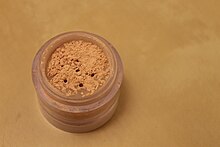powder
A powder (der, colloquially : das; from French poudre , from Latin pulvis ) is a very finely ground, dry solid . Talc , one of the softest minerals, is used as the raw material for the manufacture of powder in cosmetics . As a cosmetic product, it is mainly used to mattify the skin . But it is also available in an anti-bacterial mode of action, which counteracts skin impurities, and in colored versions, such as B. bronze powder. There is also blush in powder form.
In pharmacy , talc, zinc oxide , various types of starch (especially rice starch ), Aerosil ( fumed silica ) and the like are used as the basis . a. Here they usually serve as an active ingredient and auxiliary material , e.g. B. as a drug carrier for external use with a cooling, antipruritic, astringent or disinfecting effect.
Various types of starch (especially corn starch ) and calcium carbonate are used as the basis in printing technology .
Powdering latex gloves , typically with talc, prevents them from sticking and makes it easier for the hand to slip in, but it also transports allergens from the latex, which is why unpowdered variants, especially made of polyurethane, are offered. The same applies to condoms and femidoms . Latex balloons are typically blown off the dipping mold and powdered with lime dust to avoid sticking. When filling balloons, especially with the filling valve outlet pointing upwards, some powder sinks or swirls into the outlet and can damage a low-pressure valve.
Talcum powder is used to make the interface between the hose , mostly butyl rubber, and the rubber tires of bicycles, automobiles and the like slippery. During assembly and afterwards, the tube should be as relaxed as possible, even if the tire slips on the rim. Flexing the jacket should not rub the hose.
Powder is synonymous or more generally referred to as powder, which is a very fine bulk material .
history
The first production of powder is not documented. Numerous historical finds suggest that Stone Age people used powder for dyeing or painting. In particular, cultural make-up consisted of powder and powder made from a wide variety of materials. Hair powder was used by Roman emperors and later to give the hair a different color. Fragrance powder and wound powder were already used in the Middle Ages. In the period from the 15th to the 18th centuries, it was common to use powder for wigs . Cosmetic use for coloring or matting the skin is known well into the 21st century. Fine powdered flour or powdered sugar were known early on as separating agents and are still used today.
Areas of application
- Facial cosmetics (e.g. shaving powder before the dry shave)
- a dosage form
- Dry lubricants
- Absorption of liquids
- in offset printing as a release agent
Physical characterization
There are several physical methods of analyzing powder as powder. Methods for characterizing the particle size distributions such as static laser diffraction according to ISO 13320 and dynamic image analysis for measuring the particle size and shape are often used.
When handling large amounts of powder, the flowability of the often cohesive powder is a meaningful parameter to be characterized. The flowability and the flow location of such powders can be measured with the ring shear test according to ASTM D-6773.
In addition, test methods are available that are listed in ASTM D-6263. Below you can find the determination of the tamped density according to EN ISO 787-11 or the bulk density according to DIN ISO 697.
supporting documents
- ↑ ISO 13320: 2009 Particle size analysis - Laser diffraction methods.
- ↑ ISO 13322-2: 2006 Particle size analysis - Image analysis methods - Part 2: Dynamic image analysis methods.
- ↑ ASTM D6773-08 Standard Shear Test Method for Bulk Solids Using the Schulze Ring Shear Tester.
- ↑ ASTM D6393-14 Standard Test Method for Bulk Solids Characterization by Carr Indices.
- ↑ ISO 787-11: 1981 General methods of test for pigments and extenders - Part 11: Determination of tamped volume and apparent density after tamping.
- ↑ ISO 697: 1981 Surface active agents - Washing powders - Determination of apparent density - Method by measuring the mass of a given volume.
